The iPad Air Review
by Anand Lal Shimpi on October 29, 2013 9:00 PM ESTGPU Performance
Since the iPad Air uses the same A7 silicon as the iPhone 5s, it also uses the same on-die GPU as the 5s: IMG’s PowerVR G6430. This is a 4-cluster configuration of IMG’s latest graphics hardware, running at some relatively high frequency. I already went into some detail on the G6430 in our 5s review so I won’t rehash that here, but we’re basically looking at a shift to a more efficient scalar architecture.
I still don’t have confirmations of clock speeds, but I believe we’re looking at a max GPU clock of around 450MHz. As you’ll see from the results below, there’s a small difference in performance between the iPad Air and iPhone 5s in terms of peak GPU performance - implying very similar clocks. The difference is the iPad Air should be able to sustain its max frequency longer than the iPhone 5s can.
| Mobile SoC GPU Comparison | ||||||||||||
| PowerVR SGX 554MP4 | PowerVR G6430 | PowerVR G6430 | ||||||||||
| Used In | iPad 4 | iPhone 5s | iPad Air | |||||||||
| SIMD Name | USSE2 | USC | USC | |||||||||
| # of SIMDs | 32 | 4 | 4 | |||||||||
| MADs per SIMD | 4 | 32 | 32 | |||||||||
| Total MADs | 128 | 128 | 128 | |||||||||
| GFLOPS @ 300MHz | 76.8 GFLOPS | 76.8 GFLOPS | 76.8 GFLOPS | |||||||||
| GFLOPS as Shipping | 68.1 GFLOPS (?) | 115.2 GFLOPS | 115.2 GFLOPS | |||||||||
Since we’re talking about an A7 here and not an X-series SoC, there’s still only a 64-bit wide memory interface. As memory bandwidth is a key enabler of GPU performance I was curious to see how GPU performance compared to the outgoing iPad 4 with its much wider memory interface. Do keep in mind that the A7 does include a large system cache on-die, which can help improve effective memory bandwidth.
GFXBench 2.7
We'll start our GPU performance analysis with a look at low level results using GFXBench/GLBenchmark 2.7. The low level tests, particularly the offscreen ones, should give us some idea as to whether or not there's any increase in GPU frequency for the iPad Air vs. iPhone 5s implementations of A7.
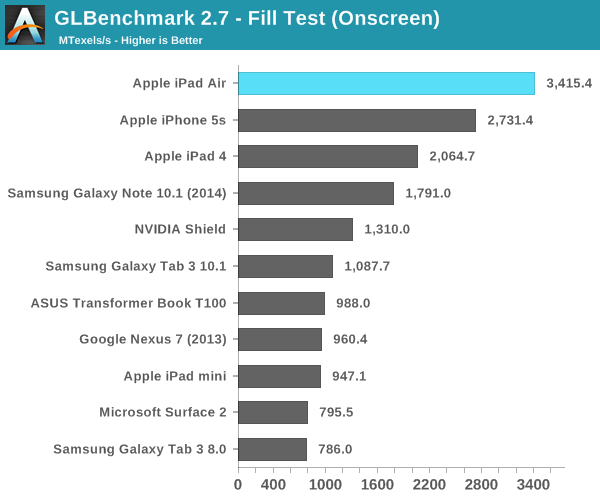
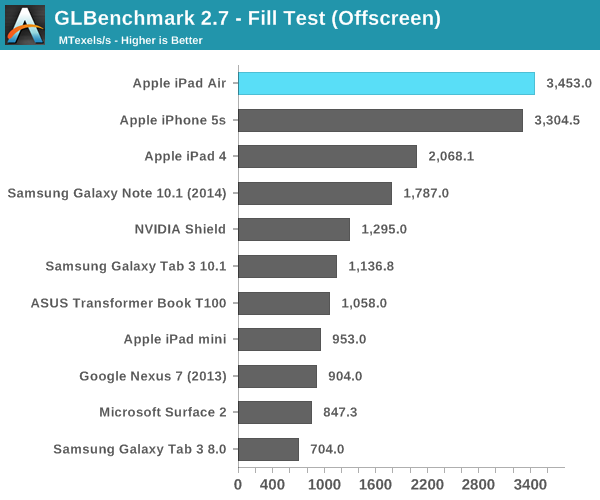
Looking at the fill rate results, there's a 4.5% increase in performance compared to the iPhone 5s. That could be the magnitude of clock increase that we're seeing between A7s. Apple could very well be relying on more thermal headroom in the iPad Air to provide any real world GPU performance advantages over the iPhone 5s.
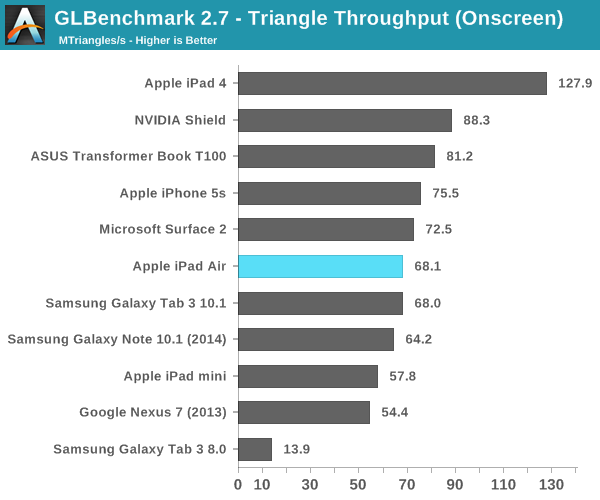

We see an even smaller gap between the Air and 5s in the triangle throughput tests (2.9%). There doesn't seem to be any substantial difference in GPU frequency between A7 implementations here. The regression in triangle rate performance compared to the iPad 4 is explained by differences in how Series 6 and Series 5XT GPUs scale in width. Whereas 5XT replicated nearly the entire GPU for "multi-core" versions, multi-cluster versions of Rogue only replicate at the shader array. The result? We don't see the same sort of peak triangle setup scaling we did back on multi-core 5XT parts. I'm not sure I'm particularly happy with the magnitude of the regression here, but I haven't seen any real world cases where it matters yet.
Next up are the game simulation tests. We'll start with the more strenuous of the two: T-Rex HD.
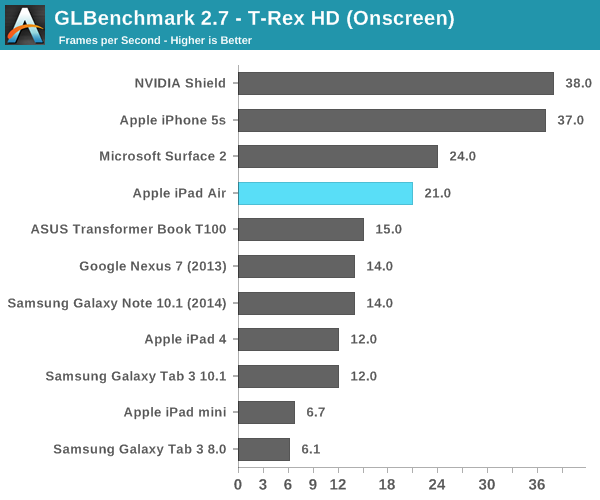
Here we get closer to Apple's claims of a 2x increase in performance. The iPad Air delivers 75% more performance than the iPad 4 in this test. Once again the iPhone 5s pulls ahead but that's because the onscreen tests render at display resolution, which is lower on the 5s.
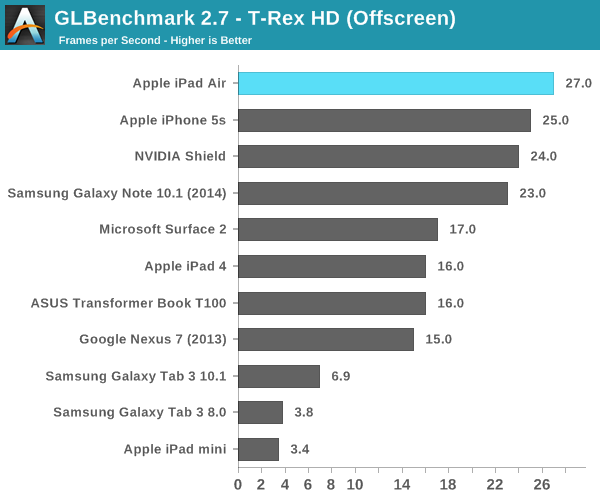
Offscreen performance sees similar scaling: ~69% better performance compared to the iPad 4.
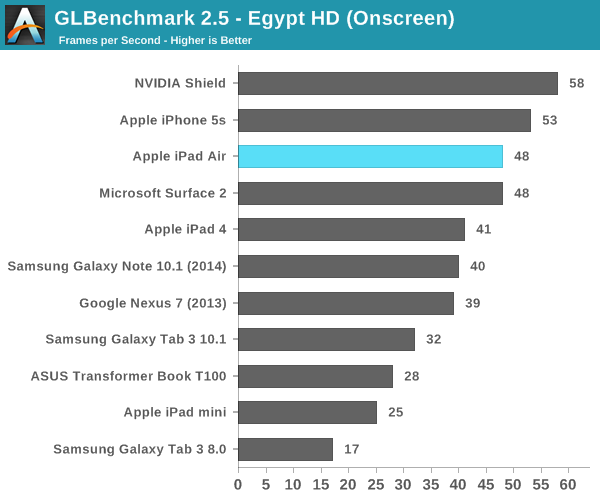
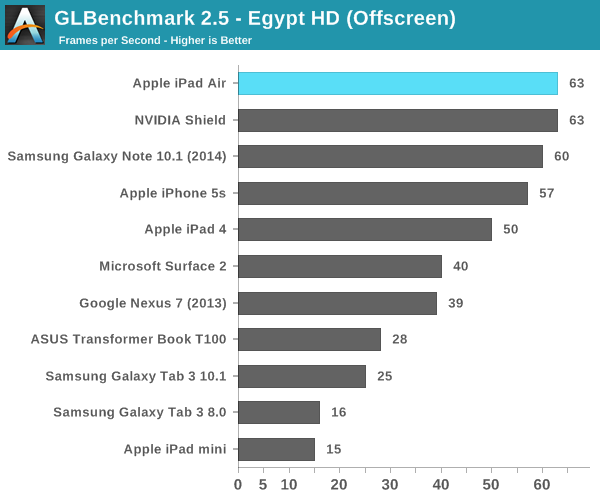
3DMark
We're once again running 3DMark's newest Unlimited mode which does its best to run independently of v-sync and at a standard resolution across all devices. I've also included 3DMark Extreme results below that feature a few more comparison points.
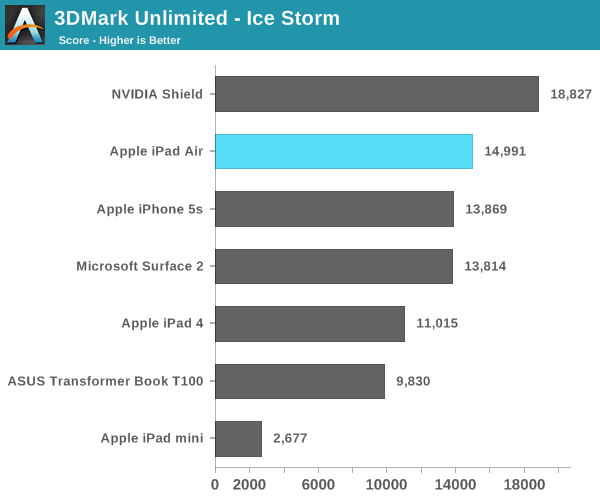
The overall Ice Storm scores show a 36% improvement in performance over the iPad 4 and an 8% increase compared to the iPhone 5s. Given the CPU frequency advantage of the A7 in the Air vs. the iPhone 5s, I'm guessing that's why we're seeing the performance gap we are here.
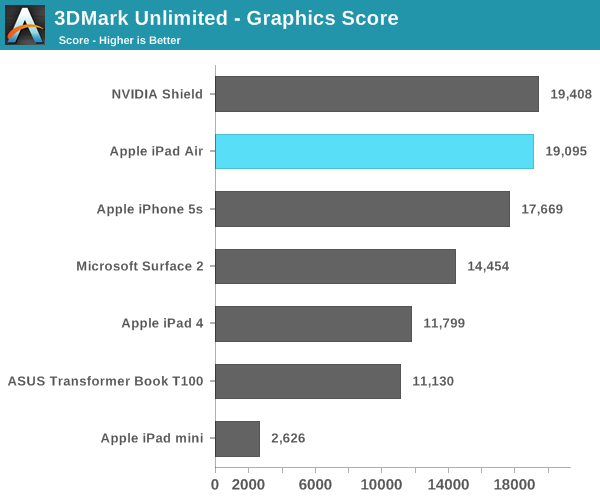
If we focus exclusively on the GPU tests (which themselves are still CPU bound), the iPad Air's performance advantage over the iPad 4 grows to over 60%.
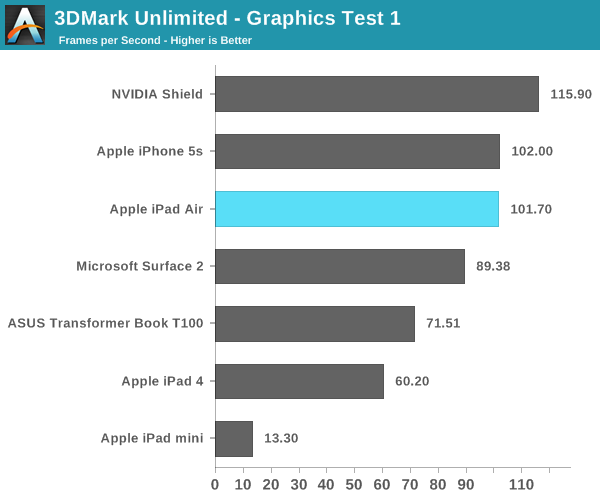
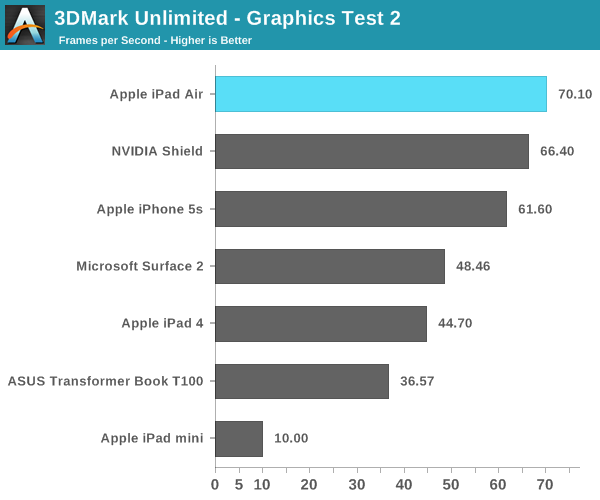
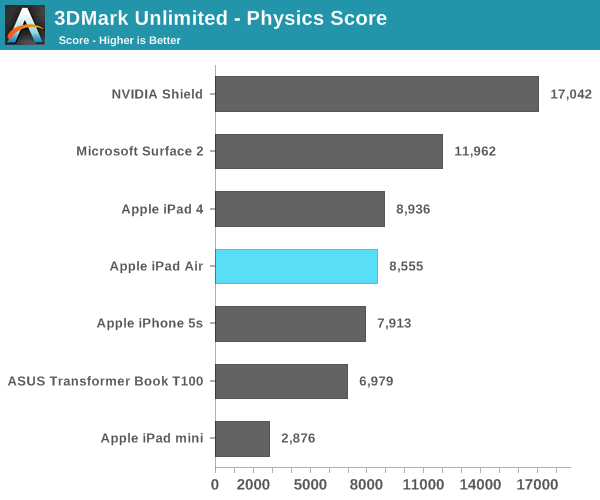
I'm still not entirely sure what's going on with the 3DMark Physics test, but we've seen this two reviews in a row now where Cyclone showed no performance increase at all compared to Swift despite this being largely a CPU test.
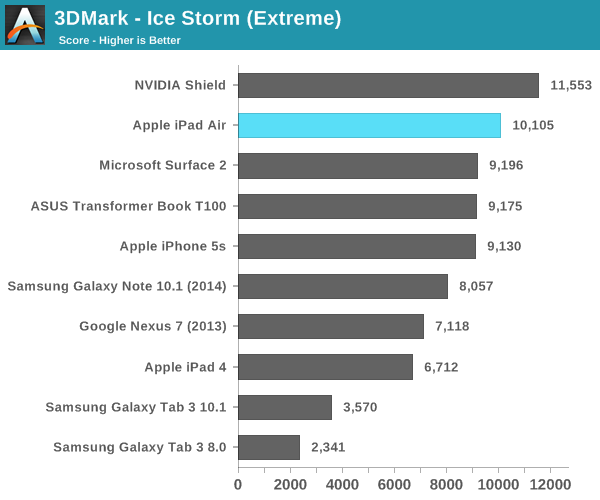
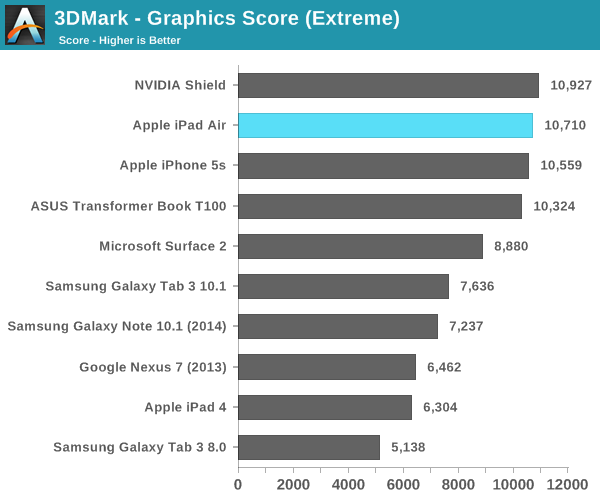
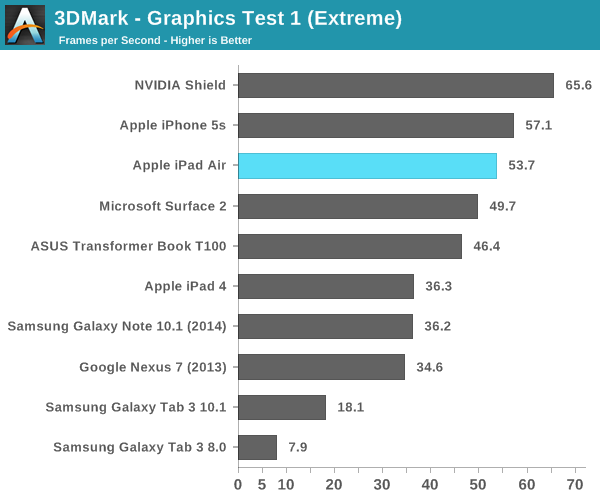
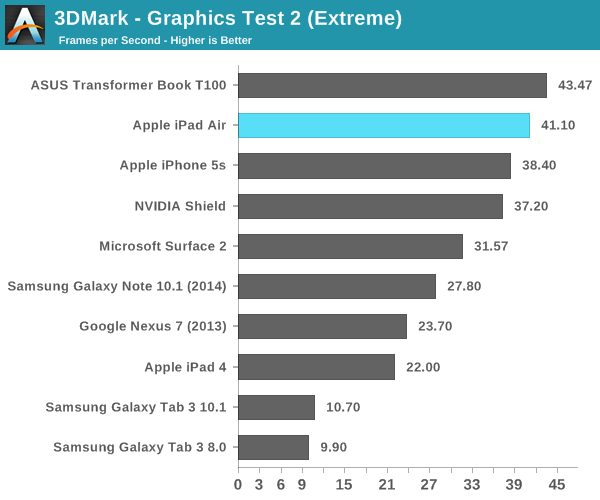

Basemark X
Basemark X is a new addition to our mobile GPU benchmark suite. There are no low level tests here, just some game simulation tests run at both onscreen (device resolution) and offscreen (1080p, no vsync) settings. The scene complexity is far closer to GLBenchmark 2.7 than the new 3DMark Ice Storm benchmark, so frame rates are pretty low.
I'm still having random issues with Basemark X reliably running both on and offscreen tests on iOS 7. Unfortunately I could only get onscreen results for the iPad Air, which came in at 46% faster than the iPad 4. Note the iPad mini and iPhone 5s benefit from having lower native resolutions here, which is why they perform so well.
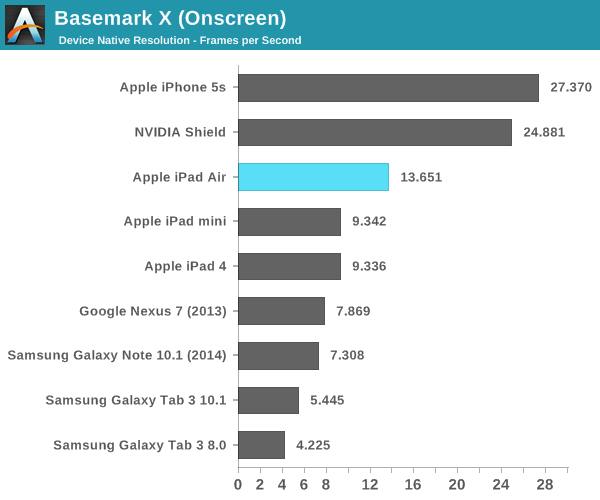










444 Comments
View All Comments
over9k - Tuesday, October 29, 2013 - link
Two paragraphs in and this is already better than all the other "reviews" out there.Beautyspin - Tuesday, October 29, 2013 - link
You should not really call any review by Anandtech of Apple products as reviews. They are homages paid to their shrine. This is a ritual with them..Drumsticks - Tuesday, October 29, 2013 - link
I always hear people complaining about bias here and elsewhere for apple products. But what exactly is the reason for that? The majority of the review is seriously objective - you can't argue that apple has some of the best performance in he game right now, and the best display to boot. He only thing rivaling it is probably the higher clocked Z3770, while Qualcomm will probably pass Apple's GPU early next year.as far as subjectivity goes, even if you don't like the design, the materials are solid. And it manages to be lighter than every other ten inch tablet on the market (and thinner) withot sacrificing battery life. The only subjective things I could possibly see are maybe the sound quality and the OS itself, of which he criticized a few times. Where does the bias come in?
Fleeb - Tuesday, October 29, 2013 - link
"and the best display to boot"We have yet to wait for the Kindle HDX review but it is lighter, packs more pixels and with 100%RGB gamut.
darwinosx - Wednesday, October 30, 2013 - link
Its lighter because it is cheap plastic. It is also a far more limited device. Really laughable to think it compares to an Air.dsumanik - Wednesday, October 30, 2013 - link
Read this review with a grain of salt. Anand lai shimpi is heavenly vested in apple stock, doing everything he can to boost the dismal situation.Thinner bezels and light weight do not hide the fact that functionally, this iPad is the same as the previous 2 generations.
Sent from my ipad3, which will be upgraded when apple actually updates the product line.
Here's some basic ideas mr cook:
Wireless charging
Fingerprint scanner
Thunderbolt sync or usb3
Haptic feedback
NFC
John2k13 - Wednesday, October 30, 2013 - link
You know what's disgusting about your comment, and those similar to yours? That you basically accuse the author of being a liar, a shill, and completely lacking in integrity- without a shred of evidence. I read the entire 10 page review, and it was incredibly detailed, precise, and well-written, something that would be obvious to most sane, rational, objective people."Anand lai shimpi is heavenly vested in apple stock, doing everything he can to boost the dismal situation."
First of all, what "dismal situation"? Apple stock is up around $130 from a few months ago, or almost a third. Hardly "dismal". Also, do you think a single review from a website visited primarily by tech geeks is going to have any fucking effect on the stock? I mean, are you for real? Don't assume the author holds the same amount of ignorant stupidity that you apparently do, to think for a second this review would have a snowball's chance in hell in affecting stock. You clearly know nothing about how the financial market works.
"Thinner bezels and light weight do not hide the fact that functionally, this iPad is the same as the previous 2 generations."
Functionality on a tablet is primarily based on software, and the iPad has 475,000+ optimized apps which are getting more powerful all the time. The hardware simply enables better software. A tablet is basically a blank slate for the software, and better hardware helps in enabling better software. Every single aspect of this iPad is improved, so yes, it is more "functional". That list you made, though, is pretty ridiculous, and obviously a desperate attempt to list anything you can think of that the iPad doesn't have and pretend its significant.
Wireless charging- why? This makes the device more functional, how?
Fingerprint scanner- Wow, brilliant "idea". You probably mocked touch ID when it appeared on the 5S. Again, this would be nice to have I guess, but in no way impedes "functionality" of the tablet.
Thunderbolt sync or usb3- I have no idea what "thunderbolt sync" means, and its pretty ridiculous you're harping on a USB3 port. It will never happen, nor should it.
Haptic feedback- Utterly useless gimmick, but heym why not, right?
NFC- I have NFC on my Nexus 4, and not ONCE have I even run into an opportunity or a reason to use it. But yeah, I'm sure you honestly think it's needed or useful on an iPad. Again, another meaningless bulletpoint you were desperate to add mindlessly.
Next time you want to baselessly accuse an author of being a liar, a shill, a sellout, and having no honesty or integrity, try to make a coherent post that actually contains some intelligent, well thought out information. Otherwise, by attacking the author you just embarrass yourself as you did now. Grow up.
ABR - Wednesday, October 30, 2013 - link
Actually thunderbolt sync is one of the changes I'm really waiting for. Have you ever tried restoring even a 16GB iPad over USB? Slow agony. I can't even imagine what someone w/a 64 or 128GB model must go through. Even ordinary everyday syncs are far slower than what they could or should be.Howard Ellacott - Wednesday, October 30, 2013 - link
You clearly don't realise what thunderbolt is, which is why that's such a stupid suggestion. Yes, faster syncs would be amazing, and restoring a 64gb iPhone is a right pain, but thunderbolt isn't the way.Kristian Vättö - Wednesday, October 30, 2013 - link
USB 2.0 isn't the real bottleneck there, it's NAND. Most eMMC solutions can't even saturate the USB 2.0 link with sequential writes, so Thunderbolt or USB 3.0 would do absolutely.